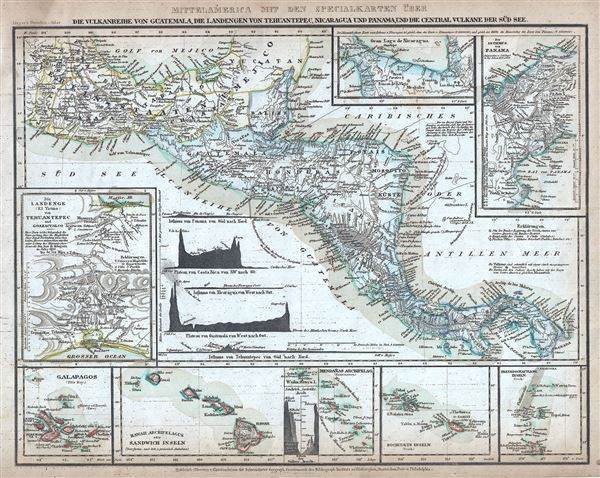This item has been sold, but you can get on the Waitlist to be notified if another example becomes available, or purchase a digital scan.
1852 Meyer Map of Central America
Mittelamerica-meyer-1852
Title
1852 (undated) 9 x 11.5 in (22.86 x 29.21 cm) 1 : 9300000
Description
This map was an area of considerable public interest through the 1850s. Before the construction of the Panama Canal the most practical route from the Caribbean to the Pacific was through Nicaragua. Known as the Nicaragua Route, this passage was controlled by the Accessory Transit Company, a property of the American tycoon Cornelius Vanderbilt. This vital trade artery was disrupted in 1854, two years after this map was issued, by the outbreak Civil War in Nicaragua. In an attempt to keep the route open, the Liberal Party of Nicaragua, under Francisco Castellon, enlisted the aid of the American adventurer William Walker. Walker invaded Nicaragua with some sixty armed 'colonists' and managed to have himself fraudulently elected President, after which is began an Americanization program that included reintroducing slavery into the region. Eventually Walker's small private army was defeated by the Central American Collation and Walker himself was repatriated to New York, where he faced charges for illegally waging war. Loathe to let go of his imperial ambitions, Walker again returned to the region, this time to British Honduras (Belize), where he was captured and executed by the British governors who saw him as a threat to their own economic ambitions in the construction of a trans-oceanic canal.
This map was issued in Meyer's Zeitung Atlas. Although all the maps in this atlas are not individually dated, the title page and maps were often updated while the imprint with the date was not, causing confusion to the exact date for some of the maps. Moreover some maps in the atlas were taped in at a later date as an update to the atlas. We have dated the maps in this collection to the best of our ability.
Cartographer
Joseph Meyer (May 9, 1796 - June 27, 1856) was a German industrialist, merchant, and publisher, active in Germany in the early to mid 19th century. He is best known for publishing the encyclopedia Meyers Conversation-Lexicon. Born in Gotha, Germany, Meyer was educated as a merchant in Frankfurt am Main. He moved to London in 1816, but returned to Germany in 1820 after his stock speculations and business adventures fell through. Once back in Germany, he began by investing in the textile trade (1820 - 24). Meyer began creating business plans concerning how to start railways soon after the first steam-hauled railway began operation in December 1835. He founded the Deutsche Eisenbahnschienen-Compangie auf Actien (German Railway Rail joint stock company) in 1845. Meyer also found great success as a publisher, utilizing the system of serial subscriptions to publications, a new idea for the time. He founded a company, Bibliographisches Institut in Gotha in 1825, which published several versions of the Bible, works of classical literature, atlases, the world in pictures on steel engravings, and an encyclopedia. He moved the Institut from Gotha to Hildburghausen in 1828. He published several atlases, including Meyer's Groẞer Hand-Atlas (1843 - 1860). In 1848, he supported the Springtime of the Peoples Revolutions that took place throughout Germany and much of Europe. When the revolutions failed in 1849, Meyer was briefly imprisoned for his support of revolutionary activities. The revolutions also began to take a toll on Meyer's business interests, and when he died, in 1856, the Bibliographisches Institut was struggling financially. His son, Herrmann Julius Meyer, took over the firm, spearheading a rapid recovery. This, and other businesses prospered under Herrmann Julius (April 4, 1826 - March 12, 1909) and when he died in 1909, he led the richest family in Saxony, with more total wealth than the King of Saxony More by this mapmaker...

